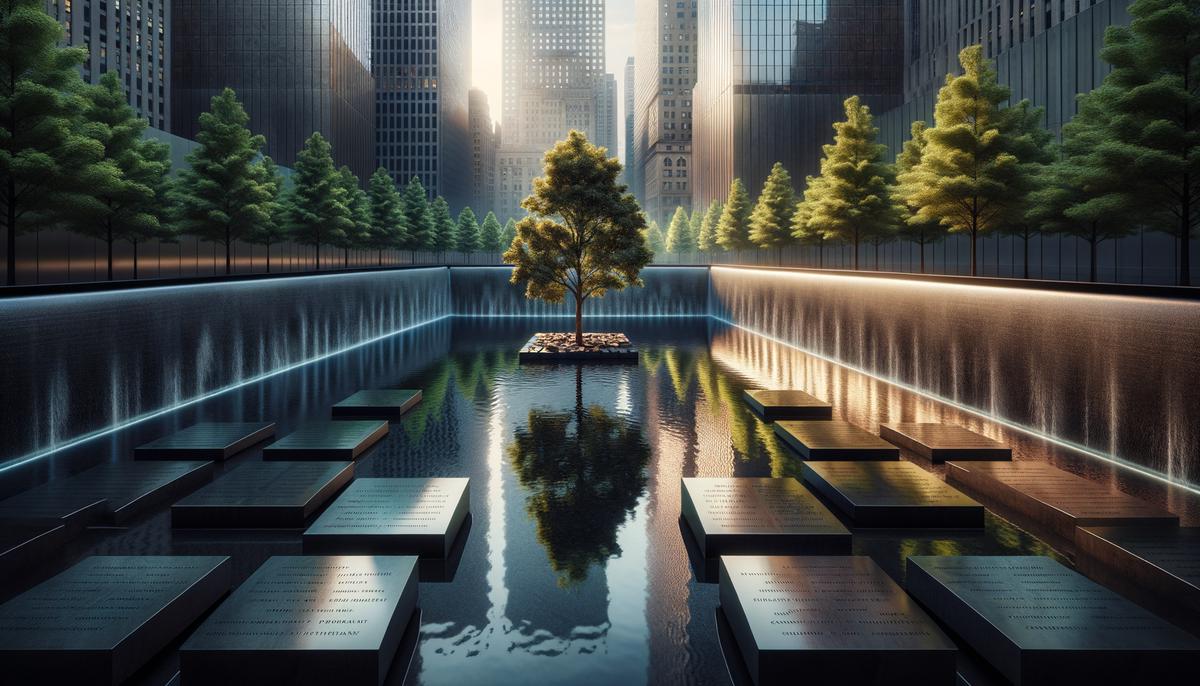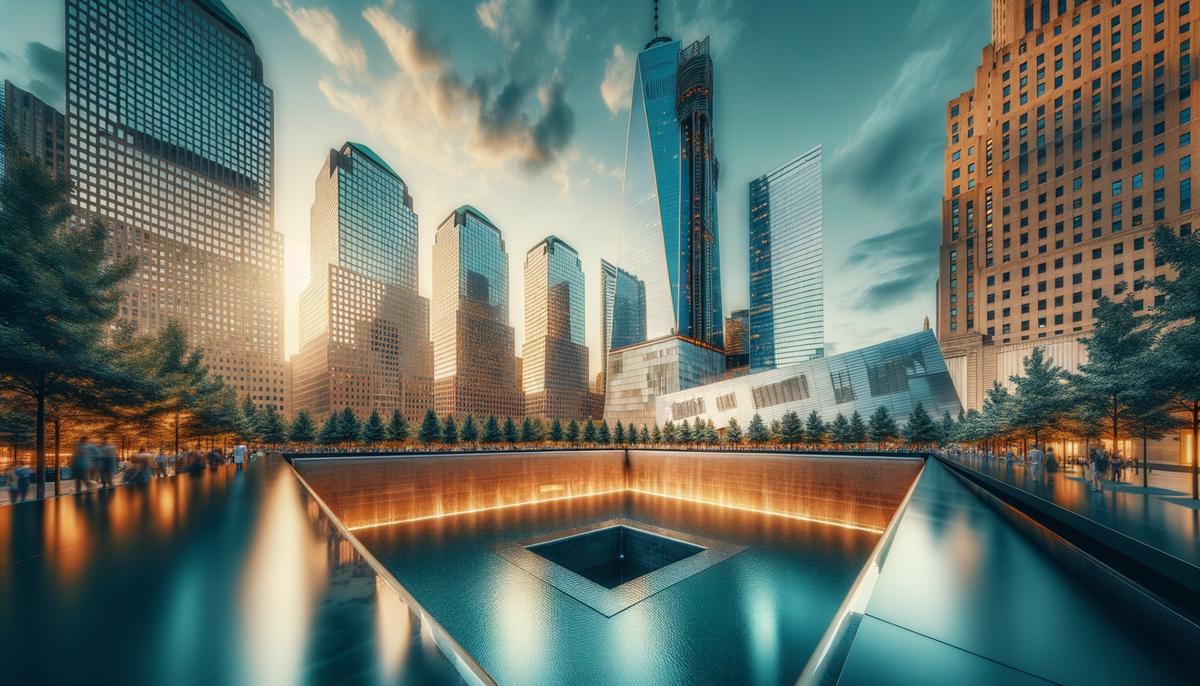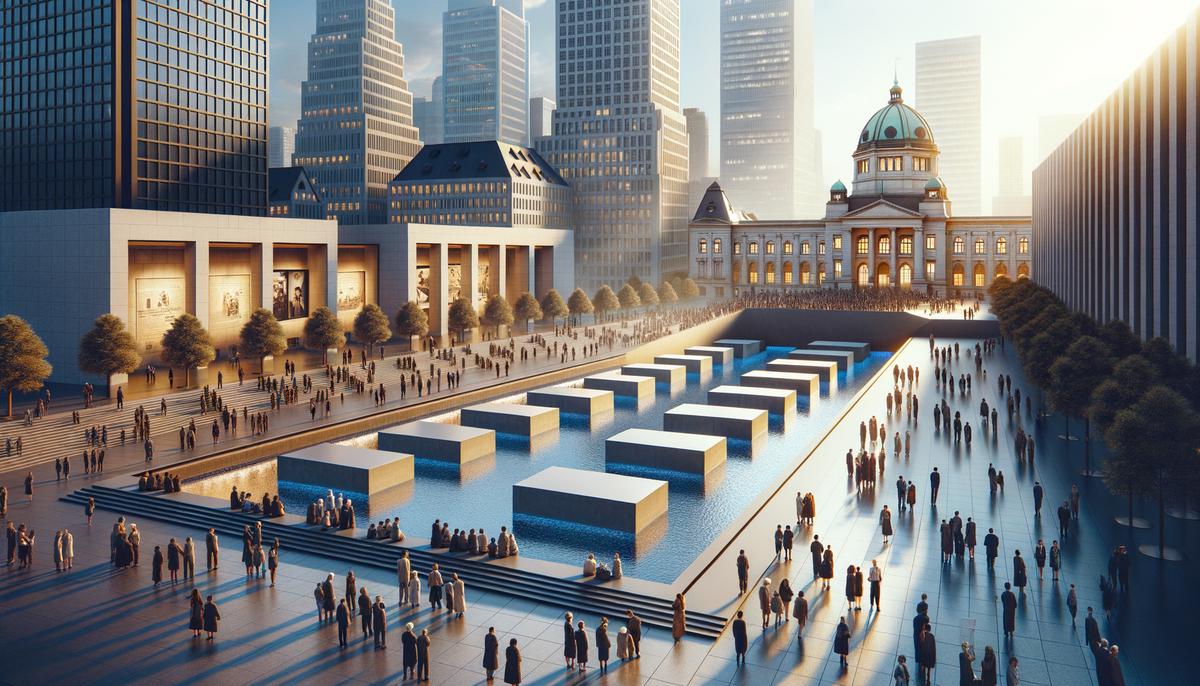The 9/11 Memorial & Museum serves as a reflection on tragedy, resilience, and the human spirit. This account guides readers through a journey that encapsulates remembrance, collective sorrow, and the hope that emerges from despair. Through an examination of the memorial's design, museum exhibits, educational programs, and the Tribute in Light, we invite you to engage with a story that resonates with our shared humanity.
Memorial Design
The 9/11 Memorial's design stands as a statement of loss, resilience, and hope. Architects Michael Arad and Peter Walker transformed tragedy into a space of quiet reflection. At its heart are two massive reflecting pools set within the footprints where the Twin Towers once stood, symbolizing the void left by the lives lost during the September 11 attacks and the 1993 bombing.
These pools, the largest man-made waterfalls in North America, create a serene atmosphere. The water's continuous flow represents perpetual remembrance. Surrounding the pools, bronze panels bear the names of those who died, ensuring visitors can touch and reflect upon each individual life cut short.
The Survivor Tree, a Callery pear tree that remarkably survived the devastation, serves as a living testament to resilience and recovery. Each Spring, it blossoms, symbolizing life and rebirth amidst somber memories.
The Memorial Glade honors those who suffered from illness related to the rescue and recovery efforts1. It features a pathway flanked by large stone monoliths inlaid with World Trade Center steel, linking past and present. It's a dedicated space that acknowledges the ongoing sacrifices made following the attacks.
Arad and Walker's design emphasizes collective healing and individual reflection. Visitors are invited to experience the space personally; there's no single prescribed path. You're free to wander, contemplate the waterfalls, touch the names, and sit near the Survivor Tree.
The surrounding plaza's swamp white oak trees offer a living contrast to the reflective pools. They symbolize strength, resilience, and growth, framing the memorial and softening the severity of loss with signs of ongoing life.
Open sightlines across the Memorial allow visitors to see others engaging with the site from various perspectives, emphasizing a shared community of remembrance. This openness encourages a silent dialogue between personal memories and collective history.
Through water, bronze, stone, and living greenery, the 9/11 Memorial embodies loss and love, despair and hope, reflecting both the scars of tragedy and the strength of the human spirit. The design speaks to our capacity to remember and move forward, grounded in the legacy of those who were lost.

Museum Exhibits
Venturing from the solemnity of the Memorial into the 9/11 Museum, visitors are ushered into a space where the narrative of September 11 unfolds with all its complexity and emotion. The Museum does not just recount facts; it evokes the human experience of that fateful day and the ripple effects that followed, through a carefully curated collection of exhibitions, artifacts, and multimedia displays.
At the core of the Museum's ethos is the preservation of individual stories – narratives that, when woven together, paint a tableau of heroism, sadness, unity, and resilience. Personal artifacts hold a mirror to the starkly personal impact against the backdrop of the global stage. Each item tells a story of a life intersected by history, offering a profound connection to the visitors.
The Museum houses both permanent and rotating exhibitions, ensuring that the narrative of 9/11 remains dynamic and relevant. "In Memoriam" personalizes the human cost of the attacks by providing a visual representation of each victim through photographs, reminding visitors of the individuals behind the numbers. Interactive stations allow for a deeper engagement with the lives they led.
The museum's architectural integration within the historical site is an exemplary feature. Parts of the original World Trade Center stand testament to resilience, while the "Survivors' Stairs" underscore escape and survival. Through this interplay between artifact and space, the museum encapsulates the devastation of that day and the steadfast resolve that followed.
Multimedia is one of the most immersive aspects of the museum. Audio recordings and visual media capture the unfolding tragedy and human responses. These installations deeply engage the senses, making the connection more visceral.
The museum also explores the aftermath and ongoing implications of 9/11 through sections dedicated to recovery at Ground Zero, global responses to the tragedy, and how lives were forever changed. It concludes with reflections on 9/11's continuing impact on the world stage2.
By weaving together tangible remnants with personal stories and multimedia elements, the 9/11 Museum offers a comprehensive exploration of September 11, encapsulating its catastrophic toll and highlighting the hope and resilience in its aftermath. Visitors leave with a nuanced understanding of the events – aware of the tragedy's scope yet inspired by individual and collective stories of courage, recovery, and renewal.

Educational Programs
Educational Initiatives at the 9/11 Memorial & Museum
The 9/11 Memorial & Museum extends its mission beyond the physical boundaries into the global classroom. Through educational initiatives and resources, the museum narrates the story of September 11 and places emphasis on fostering a comprehensive understanding of the event's socio-political implications, the resilience in the face of tragedy, and the ways societies can emerge stronger.
For Students and Teachers: Nurturing Informed Future Generations
A cornerstone of the museum's educational outreach is its programs geared toward students and educators. The museum offers various professional development workshops designed to equip educators with the tools, strategies, and content knowledge needed to effectively teach the complex subjects of terrorism, resilience, and remembrance.
Interactive student webinars bring the museum into classrooms around the world, engaging young minds with survivor testimonies, explorations of 9/11 artifacts, and Q&A sessions with museum educators. These programs encourage students to think critically about heroism, sacrifice, and the global aftermath of the attacks.
Tailored Programs for Families and The General Public
The 9/11 Memorial & Museum constructs tailored programs designed to engage families and the general public in dialogue and reflection. Story-telling sessions resonate with younger visitors, drawing them into the narrative of 9/11 through personal stories of loss, heroism, and hope.
Exhibitions play a pivotal role in educating visitors. With a focus on narrative storytelling augmented by artifacts and personal stories, these exhibits weave a fabric of collective memory that connects deeply with a diverse visitorship.
Youth and Family Programs
Special attention is given to programming for young visitors. The museum organizes scavenger hunts, interactive tours, and art-making activities that educate and stimulate curiosity and compassion. The discussion about 9/11 is extended to notions of community resilience and peace-building, ensuring that even the youngest visitors leave with a greater understanding of the world and the importance of empathy and unity.
Virtual Learning: Extending Reach and Accessibility
The 9/11 Memorial & Museum employs virtual learning platforms to transcend geographical barriers. Virtual tours, online collections, and digital learning tools offer users around the globe the opportunity to explore the stories of 9/11 from anywhere3. This vast digital offering makes access to knowledge more accessible, enabling individuals across different continents to engage with the historical and ongoing impact of September 11.
In its multifaceted educational efforts, the 9/11 Memorial & Museum emerges as an active participant in shaping an informed, thoughtful, and resilient populace. Through its programs for students, educators, families, and the public at large, the museum ensures that the legacies of those lost on September 11 are not only remembered but are also transformed into lessons that echo through generations. The museum's commitment to defeating hatred with understanding, despair with hope, and division with a communal embrace of shared humanity is perhaps its most profound contribution.

Tribute in Light
The Luminous Testament: Tribute in Light
Within the nocturnal panorama of New York City, a moving spectacle ascends towards the heavens every September 11th. The Tribute in Light, an ephemeral monument of remembrance, stands as a visual homage to those lost and a beacon of strength and hope. This remarkable installment pierces the city's skyline and the collective heart of a grieving nation, offering a shared moment of reflection.
The Tribute in Light first illuminated the city's skies on March 11, 2002, exactly six months after the tragedy. Commissioned by the Municipal Art Society and Creative Time, it was conceived by artists Julian LaVerdiere and Paul Myoda, in collaboration with the lighting design firm Fisher Marantz Stone. Designed to emulate the absence of the Twin Towers, this installation comprises 88 high-powered searchlights positioned into two square beams, echoing the footprints of the fallen buildings.
As dusk cedes to the dark, the lights begin their vigil, reaching up to four miles into the skyline and becoming visible from over 60 miles away4. The beams converse with the stars, a visual metaphor of spirits in skyward journey. For many, it encapsulates a bridge between the transient and the eternal, between human loss and cosmic continuance.
The Tribute in Light harnesses the elemental force of light against the enveloping shroud of darkness. It articulates collective memory through photons and space—a luminescent manuscript written on the night's canvas, legible across cultures and languages. This aspect confers to the Tribute a sense of universality.
For the city of New York, it serves as an annual reaffirmation of resilience and rebirth – a counter-narrative to visuals of smoke and destruction that once defined its skyline. For the bereaved and the survivors, it offers a tangible representation of loved ones' enduring presence in collective memory and their city's narrative. It honors not only those who perished but also those whose lives have been forever altered—the first responders, workers, survivors, and families whose stories of loss and courage are intertwined with the city's recovery and renewal.
Widely broadcasted and observed, the Tribute in Light has embedded itself within America's cultural lexicon of mourning and remembrance. It demonstrates how art and collective action can transform something as intangible as grief into something reassuring. The installation acts as a point around which narratives of tragedy are counterbalanced by tales of human tenacity and hope.
Its temporal nature underscores the importance of active remembrance in a world rushing forward. From sunset to dawn, it invites a pause, a breath, where reflection and resolution mingle.
In its luminary ascent, the Tribute in Light unfurls a cascade of emotions—grief, love, aspiration—illustrating that memory, even in its most poignant forms, can foster beauty and unity. Standing as a beacon against despair, it exalts the undying echoes of hope amidst the darkest nights. In the embrace of its beams, one can't help but feel woven into a larger tapestry of mankind's capacity for renewal and remembrance. Thus, year after year, this radiant tradition continues—reasserting, in beams of light, that though we are parted by death, we are bound by love.

Memorial & Museum Impact
Cultural and Societal Impact: The Transformative Power of the 9/11 Memorial & Museum
The 9/11 Memorial & Museum in New York City serves as a site for remembrance and a force in shaping societal and cultural narratives around the tragic events of September 11, 2001. Through its influence on visitors and its wider implications for society, the Memorial & Museum engages in a dialogue that extends beyond its physical boundaries.
For many individuals, a visit to the 9/11 Memorial & Museum is a personal encounter with history. The carefully curated spaces allow for reflection within a collective setting, bringing individual stories into a shared narrative. Visitors often report feeling a strong sense of connection to the lives commemorated within the Memorial.
The 9/11 Memorial & Museum also plays an important role in healing and education. By offering a comprehensive account that includes the events of the day, the global response, and stories of human resilience, the museum provides a context for understanding an event that has shaped the modern world. Educational programs foster a deeper understanding of the day's significance, contributing to a process of societal healing.
The impact of the 9/11 Memorial & Museum extends into the realms of terrorism awareness, global security discourse, and international solidarity. By presenting the events of September 11 in a factual and nuanced manner, the Museum contributes to a global conversation about the nature of terrorism, the importance of resilience, and the power of unity in responding to such acts. It raises awareness about the ongoing impact of these attacks, fostering a vigilant yet hopeful stance towards the future.
Amid the diverse narratives and emotions that the Memorial & Museum encapsulates, one central theme emerges: unity. Visitors often leave with a reinforced belief in humanity's capacity for solidarity. By witnessing stories of global outreach following the attacks, individuals internalize a sense of shared human values that transcend divides.
The 9/11 Memorial & Museum continues to leave a lasting impact, serving as a space for collective memory and individual reflection. It connects the past to the present, allowing for personal growth and societal introspection. It stands as a testament to human resilience in the face of loss and our commitment to future generations to forge a path defined by hope, understanding, and a united will to overcome adversity.
Impact of the 9/11 Memorial & Museum:
- Provides a space for reflection and connection
- Fosters healing and education
- Contributes to global conversations on terrorism, resilience, and unity
- Reinforces belief in humanity's capacity for solidarity
- Serves as a testament to resilience and commitment to future generations1

The 9/11 Memorial & Museum offers a space where memory and progress intersect, reminding us that in the face of tragedy, we find strength in unity, understanding, and the collective effort to build a future informed by our past but shaped by hope. This narrative honors those lost and highlights our shared capacity to move forward with compassion and determination.
Experience the power of AI content writing with Writio! This piece was crafted by Writio.
Leave a Reply